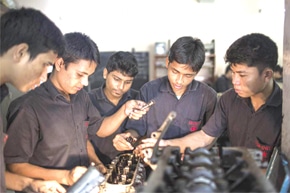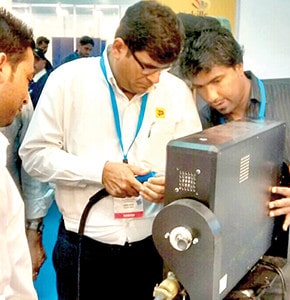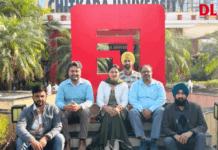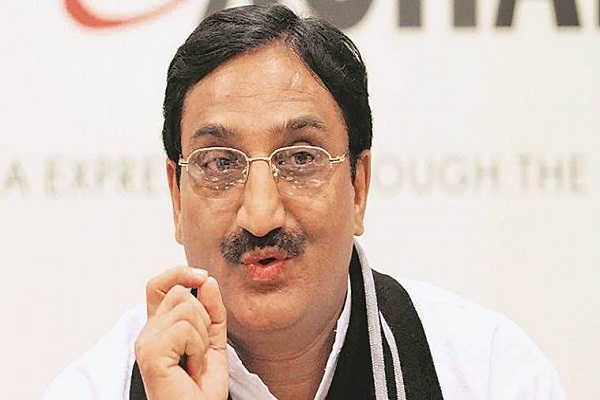
On one hand, India has a large number of educated unemployed youth and on the other, the industry is in need of skilled workers. The solution to it lies in popularising vocational courses in educational institutes. Nidhi Sharma of Elets News Network (ENN) talks to educationists and digs out the importance of vocational training stressed alongside formal education
 India would need over 500 million skilled people by 2022 across various sectors such as auto and auto components, building and construction materials, building and construction, real estate services, electronics and IT hardware, education and skill development services, food processing, gems and jewellery, healthcare, textiles, leather and leather goods, organised retail, tourism and hospitality. Besides courses in these, information technology, fashion designing, animation, clinical nutrition and many other such vocational courses are ruling the list of top favourite.
India would need over 500 million skilled people by 2022 across various sectors such as auto and auto components, building and construction materials, building and construction, real estate services, electronics and IT hardware, education and skill development services, food processing, gems and jewellery, healthcare, textiles, leather and leather goods, organised retail, tourism and hospitality. Besides courses in these, information technology, fashion designing, animation, clinical nutrition and many other such vocational courses are ruling the list of top favourite.
Vocational courses is a discipline which enables individuals to acquire skills which are traditionally non-academic and totally related to a specific trade, occupation or vocation. They are also known as technical education, carrier and technical education (CTE) or Vocational Education and Training (VET) as they directly develop expertise in a particular group of techniques or technology through manual or practical activities. On one hand, India has a large number of educated unemployed youth and on the other, the industry is in need of skilled workers. The solution to it lies in popularising vocational courses in educational institutes. Just two per cent of India’s youth and only about seven per cent of the whole working age population have received vocational training, a survey by the National Sample Survey Organisation revealed.
If India wants to emulate countries where the vocational education system has succeeded, sweeping reforms are needed. This will require significant commitment on the part of policymakers. Many of these reforms are similar to those being proposed by the 2005 Central Advisory Board for Education (CABE) Committee report on Universalisation of Secondary Education.
700 million Indians will be looking for jobs by the year 2022. What skills will they need to make a living in an economy which is increasingly based on knowledge and services?
In this backdrop, a large number of schools and colleges are encouraging their students to go for vocational training to enhance their skills. Today, a large volume of students are choosing a set of skill sets that they want to gain expertise into. Training in vocational skills is gaining strength across colleges as it prepare students for future challenges and enable to groom them for future leadership. Especially today, more and more students want to go for higher education and not just rely completely on getting skill training through vocational courses. So, there has to be an arrangement where students can get additional skill qualification with vocational course in addition to their formal education.
| The Challenges in becoming a skilled nation |
| Age is signifi cantly higher for introduction to skill development as compared to foreign countries. Some states don’t want students to be exposed to automotive at an early age, but abroad, 12-14 year old go to automotive companies. |
| Only two-five per cent of skilled population |
| While South Korea has 95 percent – 96 per cent skilled population. We don’t have a transfer space between the vocational space and the education space. |
| There is no aspiration |
| The capacity in the country does not exist. If we have to train 500 million people, or 50 or 20 million, we have to double or triple this capacity. |
| No industry standard |
| The industry has to recognise the set standards and give preference to those with certifi cates. The whole thing has to create a whole ecosystem where it will create a pull which will in turn address other three things. |
| Private and industry participation is lacking |
| No incentives for private players to enter the field of vocational education. Moreover, the present regulations are very rigid and there is no provision is there for in-service training and continuous skill up-gradation. |
| Lack of experienced and qualified teachers. Bachelors of Vocational Education (BVE) is often a mandatory qualification for teachers abroad. However, in India, no specific qualifications are being imparted for vocational education teachers. |

Bhartiya Mukt Vidyapeeth, New Delhi , Delhi NCR, City Group of Colleges, Lucknow, City Industrial Training Centre, Karauli, Rajasthan, ASMACS Industrial Training Center, Cuttack , Odisha, Audyogik Tantra Shikshan Santha, Pune, Maharashtra, Azam Industrial Training Centre, Anantnag , Jammu and Kashmir; Bi Bi Raza Vocational Training Centre for Women, Gulbarga, Karnataka, Anand Institute of Business Studies, Anand, Gujarat are some of the top colleges offering the best vocationalBhartiya Mukt Vidyapeeth, New Delhi, Delhi NCR, City Group of Colleges, Lucknow, City Industrial Training Centre, Karauli, Rajasthan, ASMACS Industrial Training Center, Cuttack, Odisha, Audyogik Tantra Shikshan Santha, Pune, Maharashtra, Azam Industrial Training Centre, Anantnag , Jammu and Kashmir; Bi Bi Raza Vocational Training Centre for Women, Gulbarga, Karnataka, Anand Institute of Business Studies, Anand, Gujarat are some of the top colleges offering the best vocational courses across the country.
About 12 million persons are expected to join the workforce every year, and an existing skill development capacity of about 3.4 million, it is thus required to enhance the skilling and technical education capacity to about 15 million (considering that even sections of the existing workforce would have to be trained)
A World Bank Survey says that vocational education courses are offered in schools at grades 11 and 12 (in most states with vocational streams, vocational and general courses are offered by the same institution). These are aimed at preparing students for entry into the labour market. There are 6800 schools, almost all in the public sector, enrolling close to 400,000 students in the vocational education scheme – utilising just 40 per cent of the available student capacity in these institutions. These schools offer a total of over 100 courses in various areas – agriculture, business and commerce, humanities, engineering and technology, home science and health and para medical skills.
MOOCs provide great benefit for Vocational Courses |
| Massive Open Online Courses (MOOCs) can provide great impetus to institutes providing vocational courses . A FICCI research paper says that they institutes can expand the availability of skilled labour with the help of MOOCs. Released at the FICCI Higher Education Summit, the paper, ‘MOOCs and the future of Indian higher education’, says that the traditional industrial training institutes can also benefit from integrating MOOCs for students and trainers. |
| The FICCI paper said MOOCs offer a way to gain skills not taught in the format sector, demonstrate them to potential employers and stay abreast of developments at the workplace. These courses are conducted online for students across the world. Over 10 million students globally have enrolled in thousands of such courses offered by just the top three to four providers of MOOCs, the paper said. |
| It also said MOOCs have garnered investments from institutions and venture capitalists. In this space, Indian students form the second largest pool of students attending MOOC courses. |
| FICCI said in the formal sector, MOOCs offer an alternative to lecture-mode classroom instruction using digital content that can be downloaded. This is on the back of huge faculty shortage in higher education. However, it said that clarity on completion and certification (drop-out rates are in excess of 90 per cent) and revenue models would have to evolve over time. |
| Even for branding, publicity and recruitment of foreign students, FICCI said Indian institutions and teachers could use MOOC platforms to create and conduct MOOCs for students all over the world, similar to universities abroad. Since employability of graduates continues to be an issue, FICCI has suggested that there could be language, communication and soft skills MOOCs to bridge the gap. |
| While the government has recently launched Swayam – an Indian MOOC platform – FICCI has said the government should develop systems to certify competence of people who have taken MOOC-based courses. It added that National Assessment and Accreditation Council (Naac) and the National Board of Accreditation (NBA) can accredit MOOC programmes and courses for use in credit transfer between MOOC providers and formal and non-formal educational institutions. |
| Apart from having MOOCs to train teachers, FICCI has suggested that employers may encourage their own human resource departments to arrange for continued education of their employees in emerging areas of technology or management. This will also help boost their vocational skills. |
The report further says that overwhelmingly, students who get through the vocational stream want to proceed to further education. This is not surprising given the relatively weak labour market outcomes. The few rigorous evaluations of programme impacts that have been undertaken point to low levels of gainful employment of these graduates.
Captain Sandeep Malhotra, Director, Alliance Educare and Research Private Limited says, “At the outset, we all acknowledge that institutions follow very fine academic practices for imparting regular curriculum. However, the country’s employment data shows that 82 per cent students face employment crisis due to the gap between their acquired knowledge and the industry needs. As we know, India is a nation with 65 per cent population below 35 years. It poses a tough challenge of skill training of 500 million people by 2022. However, if achieved, it offers a great opportunity of being a large pool of skilled workforce available to us and, to the world.”
“Existing institutions are faced with new challenges as education can no longer only be conveyed in the classrooms, students and trainers require more and more modern means of communication for knowledge pass. Further, the institutions have limited knowledge resources, whereas, large pool of experts is available outside their boundary wall. This expert pool may be utilised by digitally connecting the institutions with the outside world”, Capt. Malhotra added.
Speaking in this regard, Dilip Chenoy, Managing Director and CEO of the National Skill Development Corporation (NSDC), informed that presently there are three programmes that are running across schools and colleges. “The first is the traditional one in schools – the 10,000 vocational schools that existed when they were introduced in vocational education. Second, is the introduction of vocational courses by CBSE and the other boards. The third, which is actually integrating the other two and is spread across the country is the National Vocational Education Qualifications Framework (NVEQF), now the National Skills Qualifications Framework (NSQF), which is introducing skill development classes between 9 and 12 in the different states.”“There are two models operating. While some states are doing it on their own, in majority states NSDC is partnering with the state governments to introduce training partners and set up labs and get people skill trained. Two very recent examples are in Haryana and Himachal Pradesh where school children who passed out of 12th and not wanting to continue higher education have got jobs upto Rs. 50,000 a month based on their skill certificate. In many cases where they have not even passed 12th but passed their skill certificate, they have got jobs in the market, say for example in the retail sector, where they are earning an average of `12,000- `13,000 per month”, added Chenoy.
“Moving on from the school space to higher education, AICTE has set up community colleges and they have the skill knowledge providers. The University Grants Commission (UGC) has set up community colleges and they have the bvoc programme going on. NSDC is partnering with them. NSDC hopes to double the number of states this year and take the number of schools and colleges to at least three times”, he further informed.
While the school education sector is about 227 million in enrolment, the combined enrolment in higher education and vocational training is about 15.3 million.
It may be mentioned that in the higher education space, institutions such as the Delhi University (DU) and Pune University, students are getting an add on course on the payment of fees where they get assessment certificate from SSC. It helps them with jobs. A very good example is that of Dayal Singh College of DU where a batch completed a banking and financial course. Some of them have got placed in global consulting companies with decent packages.
While Haryana and Himachal Pradesh are very robust states in the field of vocational training and courses, West Bengal, Madhya Pradesh, Chhattisgarh, Maharashtra, Punjab, Rajasthan, Telengana and Andhra Pradesh are also making good progress. The response varies from state to state.
























